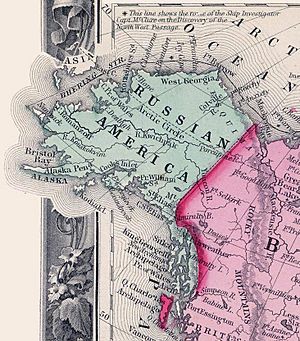Treaty of Saint Petersburg (1825) facts for kids
The Treaty of Saint Petersburg of 1825 was an important agreement. It is also known as the Anglo-Russian Convention of 1825. This treaty set the borders between areas claimed by Russia and Great Britain in North America. These areas were on the Pacific Coast, including what is now Alaska and parts of Canada.
The official name of the treaty was very long: the Convention Concerning the Limits of Their Respective Possessions on the Northwest Coast of America and the Navigation of the Pacific Ocean. It helped decide who owned which parts of this vast region.
Contents
Setting the Borders
This treaty drew lines on the map to separate Russian and British lands.
Coastal Boundaries
- The agreement started at the southern tip of Prince of Wales Island. This is near a line of latitude called 54°40′ north.
- From there, the border went north along the coast up to the 56th parallel.
- Prince of Wales Island itself was given entirely to Russia.
- The border then moved inland, about 10 marine leagues (about 55 kilometers or 34 miles) from the coast.
- This coastal part of the border was already agreed upon with the United States in a treaty a year earlier.
Inland Boundaries
- After going inland, the border turned north and west.
- It followed the 141st meridian west all the way to the "Frozen Ocean."
- The "Frozen Ocean" is what we now call the Arctic Ocean.
- This part of the border is still the line between modern-day Alaska (part of the United States) and the Yukon (part of Canada).
What Happened Next
- The land Russia claimed in this area was later sold to the United States. This land became the State of Alaska.
- The British claims along the coast became part of British Columbia, a province in Canada.
- The inland areas defined by the treaty became the Yukon territory in Canada.
- The treaty also set rules for ships and ports in the region.
Later Problems and Disputes
The treaty tried to divide the land clearly. However, some parts of the agreement were not very clear.
The Alaska Boundary Dispute
- The treaty said Russia would control the coast, and Britain would control the inland areas between 56 and 60 degrees north latitude.
- But the exact meaning of the words used in the treaty was unclear.
- This led to disagreements later on, especially in the Alaska boundary dispute.
- This dispute was between the United States (who bought Alaska from Russia) and Canada (with Britain representing Canada).
Rights and Conflicts
- The treaty gave British ships the right to trade and use rivers in the area.
- In 1834, the Hudson's Bay Company (a British trading company) tried to use these rights.
- But the governor of the Russian-American Company (a Russian trading company), Ferdinand von Wrangel, stopped them. He used warships to block their access.
- This conflict was called the Dryad affair.
- It led to a new agreement, the RAC-HBC Agreement.
- In this agreement, the Russian company leased a part of the coast to the Hudson's Bay Company.
- The Hudson's Bay Company also agreed to supply Russian settlements with food and goods.
- They also dropped their demands for money because of the Dryad affair.
Gold and Access
- In 1862, the treaty's rules allowed British people to reach the Stikine River goldfields.
- However, when the United States bought Alaska in 1867, they did not agree to these same rules.
- This caused more arguments about British access to the inland areas.
- The treaty's terms about the Arctic Ocean (the "Frozen Ocean") were also important. They played a role in the Bering Sea Arbitration and other legal decisions about ocean areas near Alaska.
See also
 In Spanish: Tratado de San Petersburgo (1825) para niños
In Spanish: Tratado de San Petersburgo (1825) para niños


